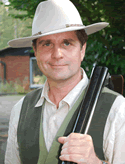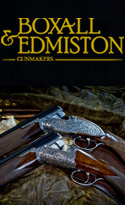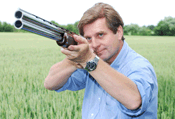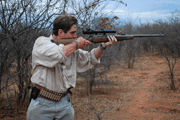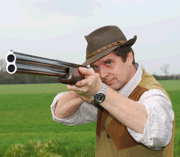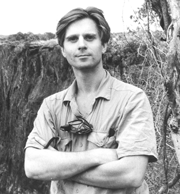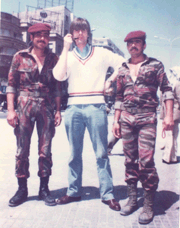Mojo Versus Method
Clay shooting is a wonderful thing and there all sorts of ways to go about it. My own approach is quite analytical (although I strictly limit what I think about on the firing point). I do not automatically advise an analytical approach to others, and, I acknowledge that many have a more instinctive, less considered, way of shooting. I would argue, though, that most of us need to understand the basics of what we are doing, and what we need to do, to achieve consistent success. One must not become too obsessive, though. And, just to complicate the issue, I also believe in the development and full use of hand-to-eye co-ordination.
There are a group of shooters, moreover, who seem to make a purely instinctive approach. I am going to call them the Mojo Maestros. Mojo shooting at its best can be dynamic, confident, even aggressive. You would rarely describe it as thoughtful. If you asked Mojo shooters what they did, they either wouldn’t know, or, wouldn’t care. It would be a fair bet that they did not see lead consciously, though, and that their approach to set up and shooting would be essentially intuitive. Although this is not usually my way, it can work brilliantly. But, it is not an approach that I would generally advocate – especially to someone who was striving to improve. Nevertheless, the Mojo shooters have something important to teach us...read on.
Continuing to explore the ideas stated above, the mass of shooters tend to fall into two camps by my observation as shooting instructor over the last 30 years: THINKERS and FEELERS. Which are you? The thinkers try to rationalise everything that they do. Their conscious mind is in control all the time. They may find it hard to ‘let go.’ The feelers, and the Mojo shooters may sometimes be elite members of this tribe, don’t bother much with intellectual considerations and just get on with the job – good or bad results ensuing.
In another context, I have written: “Usually, thinkers need to learn to feel more – i.e. to learn to trust themselves more and let the inner, unconscious, self take charge on occasion. They may also need to direct their attention to areas where thought is productive, for example, in developing a pre-shot preparation plan – rather than a hindrance to performance – for example, worrying too much about their chokes, cartridges and gun-fit.”
At the level of intermediate or club shots, feelers – who, often, have had very little formal training and may not have been much bothered with fine points of technique – generally need to think more about fundamental aspects of their shooting technique. For example, how they set themselves up in relation to the break point for the target, and how they position the gun and their eyes before calling for the bird. Most are ill-advised in my view to rely on instinct alone unless they happen to be especially gifted (and even then there may be times when some conscious thought is a positive). How many times have you watched someone shoot a bird for which they were completely ill-prepared? I have lost count – many thousands. A little extra thought about a bird and discipline in setting oneself up to shoot it, meantime, can buy a bucketful of targets.
Some Mojo shooters may be the exception to the rule stated above, however. They are a subset of the feelers, but they can achieve success without much conscious or forced thought. Why? First, because they have much experience of many presentations, from long practice they learn in their own way to set themselves up well (they might not be able to describe what they do, but they do it anyway). When it comes to shooting, their mind is not cluttered with unnecessary thought. Their focus is on the bird and nothing else. And, because Mojo Maestro tends to shoot with controlled aggression – his gun keeps moving. Stand in the right place, address the bird well, lock your eyes to it, and, keep the gun moving, and you have a very good chance of connecting with the target!
Let’s return to normal mortals. In my instruction, I advocate both subconscious and conscious approaches at different times – an integration of two aspects of human nature. My usual goal is to build a better shotgun marksman or woman through improved understanding of precisely what it is that you ought to be doing and precisely when you ought to be doing it (all to be explore in more depth in future articles). This sort of rational thought process is associated classically with the left (logical) side of the brain. One should also try to develop, try to facilitate, subconscious, intuitive, right-brain performance.
Instinct and intuition, however, may not be quite as instinctive or intuitive as one might at first think. There may be an element of learning and experience incorporated. For example, hand to eye co-ordination may be much improved by learning to look at the bird really well – staring the clay to death as a student recently and most memorably put it! Once you have done this, once you have taken on board the need to lock your vision on to every target as if your life depended on it, and once it has become habitual, you have, effectively, trained your intuition and instinct. We are getting left and right brain to work together and, one might say, befriend each-other.
Let me quote myself again: “Vision is not just a natural ability, however. It is an active, directed process: a skill, to be practiced and refined. Watching the bird may sound simple, but it is incredibly difficult to achieve every time that you raise a gun to bird. The optic muscles of the shooter need to be trained (just as the muscles of the athlete). The mind needs to take on board the importance of sustained focus to consistent shooting success. Increased awareness – for example, the knowledge that sustained fine focus requires considerable physical and mental effort and that any external distraction may bring focus back to the gun (potentially causing the barrels to stop and rise) – must be developed.”
It does not end there, of course. There needs to be preparation and a plan. You must have a well-fitted gun and properly diagnosed eye dominance. You must have trained your body and mind well. You must know how to set yourself up for the shot; you must understand the need for widely different forward allowances at different ranges; you must keep the weight forward and the head on the gun as the swing and mount progress, and, you must use the front hand well and follow through smoothly. You should, moreover, have learned to shoot with good rhythm and without excessive body tension. All these things, and many others, are necessary to develop or, if you prefer, to programme, ‘intuition’. It is, in other words, something that can be much improved by experience, practice and deliberate training.
What is beginning to become apparent is there may not be so much difference between the sophisticated methodical shot and the Mojo shooter. They both end up doing the same thing, though they have come to it by different routes. We all need to taken into account the target – its flight line and angle of presentation, its type, its speed, if it is affected by any external forces such as wind. We all need to prepare ourselves well for the shot. We all need to sustain fine focus on the bird. And, we all need to keep the gun moving and follow through well (and if I am repeating myself in any of this, no apologies – it is all critically important).
The methodical shot needs a plan to do all this stuff well, the Mojoman, if he is good, does it instinctively. The big the thing that the Mojo shot has to teach the rest of us is that uncluttered shooting can work brilliantly. Freeing one’s mind of unnecessary or neurotic thought (which paralyses some people). The Mojo shot – who may appear or actually be arrogant of manner – may also have better psychological ‘armour’ against distraction or deliberate attempts to put him off. He falls down though when his instinctive style fails to read the bird correctly and the wheels fall off. When that happens he may not understand what is happening, whereas the sophisticated method shot might resort to a change of technique. For example, the CPSA ‘pull-away’ method is a brilliant ‘get-you-out-of-trouble’ method. It establishes an immediate barrel-bird relationship (so you know you are in the right ball park) and encourages you to get in front of the bird once you have established a relationship with it.
So, what are you? Mojo or Method? Thinker or Feeler? Could you perhaps improve your scores by learning from the opposite type. I bet you could.


